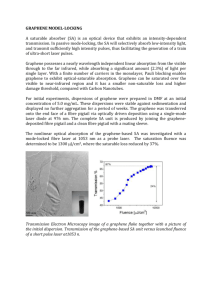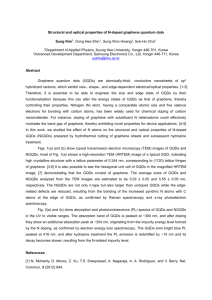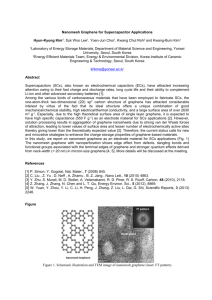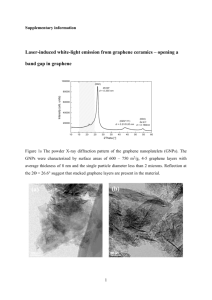Supplemental Material
advertisement
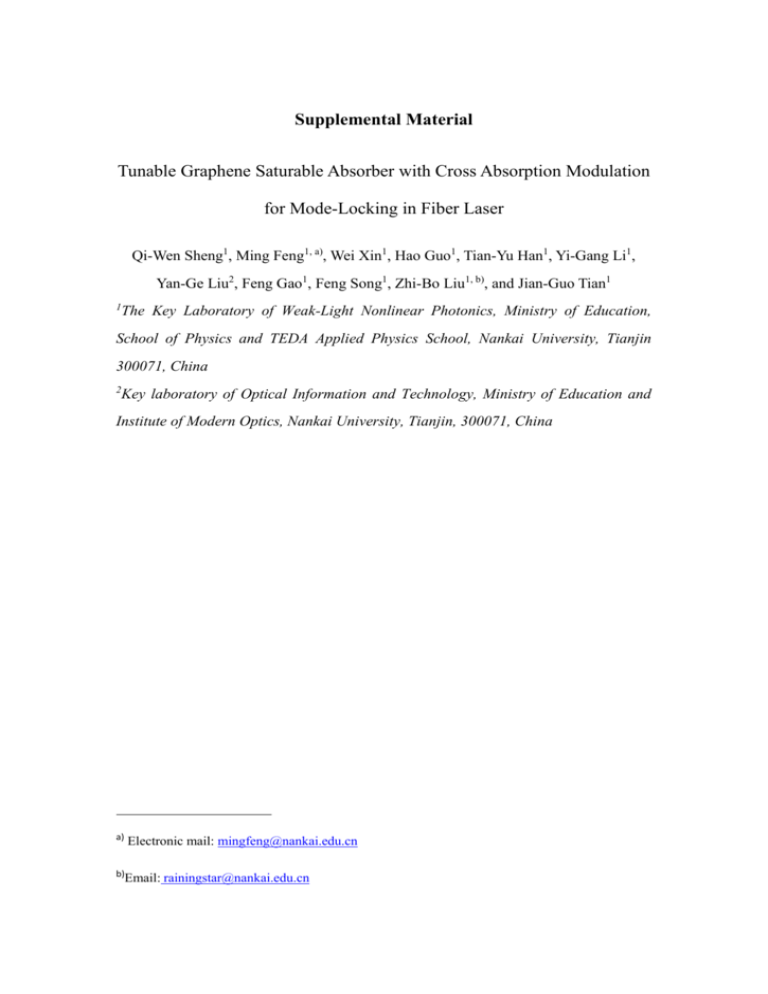
Supplemental Material Tunable Graphene Saturable Absorber with Cross Absorption Modulation for Mode-Locking in Fiber Laser Qi-Wen Sheng1, Ming Feng1, a), Wei Xin1, Hao Guo1, Tian-Yu Han1, Yi-Gang Li1, Yan-Ge Liu2, Feng Gao1, Feng Song1, Zhi-Bo Liu1, b), and Jian-Guo Tian1 1 The Key Laboratory of Weak-Light Nonlinear Photonics, Ministry of Education, School of Physics and TEDA Applied Physics School, Nankai University, Tianjin 300071, China 2 Key laboratory of Optical Information and Technology, Ministry of Education and Institute of Modern Optics, Nankai University, Tianjin, 300071, China a) Electronic mail: mingfeng@nankai.edu.cn b)Email: rainingstar@nankai.edu.cn Figure S1. The schematic experimental setup for measurement of saturable absorption of GSA. Figure S1 schematically shows the experimental configuration. Stable continue wave lasers with wavelength 980 and 1550 nm are used as sources to measure the nonlinear characteristics of microfiber based graphene saturable absorber (GSA), respectively. The output power of the laser is controlled by an attenuator and spliced with a coupler. One part of the light occupies ten percent to monitor the power coupled into the GSA, while the other part occupies ninety percent monitoring the output power form the GSA. Figure S2. The experimental data of the nonlinear absorption of GSA to modulation light and probe light. Figure S2 illustrates the experimental results that the modulation light (980 nm) causes significant saturation absorption with a power about 20 mW, while the probe light (1550 nm) need power larger than 100 mW to cause saturation absorption. This mainly results from the difference mode field distribution of light with different wavelength in the microfiber. The single mode or multimode condition of air-clad waveguide could be given by the normalized frequency V V 2 0 a n12 n22 2.405 (1) where a is the fiber radius, λ0 is the operating wavelength, and n1 and n2 are the refractive index of microfiber and air-clad, respectively. Thus, the normalized frequency of microfiber could be estimated using the Equation (1). Giving the value of a=4 μm, n1=1.46, and n2=1, the normalized frequency of modulation light (λM=980 nm) and probe light (λP=1550 nm) are VM=27.18 and VP=17.19, respectively, which is much larger than 2.405 and indicates the microfiber is a multimode waveguide at λM and λP. In a multimode step-index fiber, the number of modes Nm propagating can be approximated by [1] Nm V2 2 (2) Thus, the number of modes of modulation light and probe light are 369 and 147, respectively. It is well known that more energy will distribute at the interface of core/cladding when the light propagates as higher order mode in the fiber. Therefore, it is clear that the light with wavelength of 980 nm has much higher amplitude at the interface of microfiber/graphene/PDMS, and has much higher interaction with graphene than light with wavelength of 1550 nm does. As a result, the intensity of modulation power (980 nm) for initiating the saturation is much lower than the intensity of signal power (1550 mm). Additionally, it can be seen for Figure S2 that the loss of modulation light is larger than probe light. This also proof that the modulation light has stronger interaction with graphene than the probe light. The similar conclusion could also be achieved from the comparison with reference [20]. In the reference [20], the diameter of the waveguide that Tong el al. used is just about 1.2 μm. From Equation (1), we can get the V value is 2.45 which is just a little bigger than 2.405. It means that if the influence of graphene to the microfiber is not ignored, the waveguide is a single mode waveguide, and the most energy of pulses will be confined in the microfiber. Therefore, higher intensity is needed to initiate the saturation. Moreover, from the experiment results of reference [20], the peak energy of pulses to cause significant saturation absorption is more than 200 MW/cm2, while in our work the peak intensity is just about 10 MW/cm2. Furthermore, the progresses of continue wave and pulses interaction with graphene is different leading to the difference of threshold that cause saturable absorption of graphene. When the pulses are coupled into the GSA, the rising-edge of pulses suffers a larger loss than the falling-edge resulting from the low energy of rising-edge that cannot cause the saturable absorption of graphene, as shown in Fig. S3. Moreover, the effect will be more clearly when light propagate a long distance along the graphene (in our case, the length of graphene along the fiber is about 1 cm). However, the continue wave could continuously keep a high energy level when it couples into the GSA. Therefore, comparing the different progress of pulse and continue wave interaction with graphene, the loss of pulse is much larger than the continue wave resulting in a higher threshold of modulation light to cause significant saturable absorption of graphene. Figure S3. The single pulse of the fiber laser to measure the saturation absorption of GSA obtained from the oscilloscope. In conclusion, considering the theory and experimental results, the intensity of continue wave that could cause significant saturable absorption of graphene is much lower than the peak intensity of pulses.
